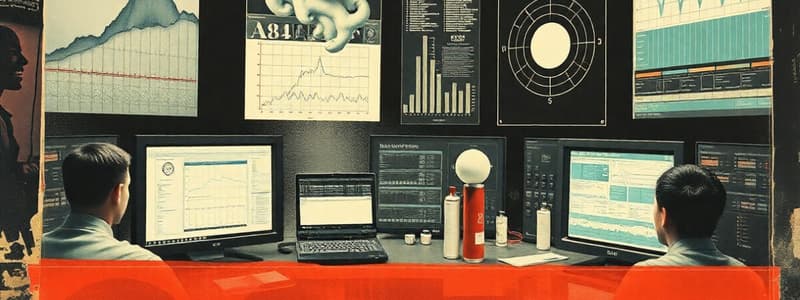Podcast
Questions and Answers
What is a defining characteristic of a group display in a DCS?
What is a defining characteristic of a group display in a DCS?
- It shows the overall performance of the entire plant.
- It presents real-time data for a single control loop.
- It incorporates alarm statuses and operational reports.
- It displays multiple control loops in a structured arrangement. (correct)
Which type of display provides information on a single loop and includes detailed properties like limits and constants?
Which type of display provides information on a single loop and includes detailed properties like limits and constants?
- Overview Display
- Trend Display
- Group Display
- Detail Display (correct)
How does the overview display represent the deviation of process variables from set points?
How does the overview display represent the deviation of process variables from set points?
- As a vertical bar indicating the deviation. (correct)
- Through a line graph depicting historical data.
- By changing the color of the background.
- As a numerical value displayed in a text box.
What information do standard displays primarily use?
What information do standard displays primarily use?
Which of the following types of display shows the essential parameters of multiple groups in a rectangular format?
Which of the following types of display shows the essential parameters of multiple groups in a rectangular format?
What is a common feature of standard displays in a DCS?
What is a common feature of standard displays in a DCS?
What capability does the group display provide the operator related to alarm management?
What capability does the group display provide the operator related to alarm management?
What type of display is primarily used for operational reports on plant performance?
What type of display is primarily used for operational reports on plant performance?
Flashcards
DCS Display
DCS Display
A display that shows a plant's overall operating situation, including status, alarms, and data, allowing operator control and reporting on plant performance, maintenance, and planning.
Standard Display
Standard Display
A predefined display format for alarms, control loops, and controller groups in a plant area, using symbolic and alphanumeric information.
Group Display
Group Display
A display showing operating parameters of a group of control loops (e.g., 4-16 loops), arranged like instrument panel faces, with bar graphs for process variables and output signals.
Overview Display
Overview Display
Signup and view all the flashcards
Detail Display
Detail Display
Signup and view all the flashcards
Trend Display
Trend Display
Signup and view all the flashcards
Graphic Display
Graphic Display
Signup and view all the flashcards
Process Variable
Process Variable
Signup and view all the flashcards
Study Notes
DCS Displays
- DCS stands for Distributed Control System, a dynamic control system.
- Controllers are spread throughout the system, connected via a network.
- Displays provide an overview of overall plant operation.
- Displays show status, alarms, and data.
Types of DCS Displays
- Introduction to DCS Displays: An overview of the types of displays for DCS.
- Standard Displays: Based on plant operator experience and research, providing predefined alarms, control loops, and plant areas.
- Group Display: Shows operating parameters of multiple control loops (e.g., 4, 8, 12, or 16 loops) arranged like instrument faces. Each loop is represented by a rectangle with bar graphs for process variable and output signals. Operators can select loops, modes or set points. Associates alarm priority and sequential operation arrangements.
- Overview Display: Shows essentials of multiple groups in separate rectangles. Set point is shown as a straight line. Deviation from set point appears as a vertical bar. Displays can include digital conditions.
- Detail Display: Specific to single loops or control functions, including additional information (constants, limits, characteristics). Lists sources of signals coming into the display.
- Trend Display: Shows a profile of a process variable's values over time, similar to a chart recorder. Gives valuable insight into recent operating patterns.
- Graphic Display: Provides realistic pictures of a process portion, including process and control information. Often interactive with dynamic changes due to real-time information and movement capabilities.
Additional Information
- This presentation covers introductions to DCS displays, standard displays, trend displays, and graphic displays.
- The slideshow includes diagrams showing DCS network structure and examples of various types of displays.
Studying That Suits You
Use AI to generate personalized quizzes and flashcards to suit your learning preferences.




